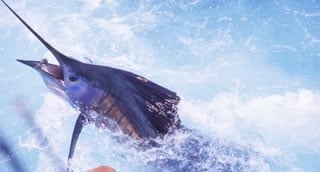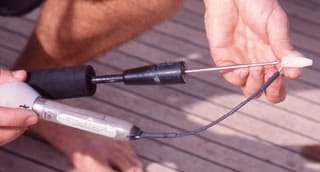
“Some of the most memorable days of sport fishing for the average angler, not just the professional, have taken place in the waters of Central America. We’ve got to do something to bolster billfish populations, or these once fertile areas may no longer sustain an abundance of billfish.” – Joan Vernon, avid angler, boat captain, tournament organizer, committed conservationist and organizer of Costa Rica tagging expedition
| A better understanding of billfish movements in Central America will help guide fishery managers to better decisions. |
Joan Vernon recognizes that Central American billfish populations are nearing the point of crisis. Unless something is done to coordinate management of these important game fish, opportunities to experience one of the greatest thrills in sport fishing may be lost forever. Those who know Vernon know she’s not the type of person to sit back and do nothing about a problem that threatens the sport she loves. And that’s a good thing, because her tireless commitment to billfish conservation is leading to real solutions.
Vernon pursues billfish conservation with the same tenacity that has enabled her to land more than 1,000 billfish during the approximately 15 years she has kept records. She actively promotes the use of circle hooks, which help ensure the survival of released fish. She works with Central American governments, U.S. agencies such as NOAA, marine conservation programs at U.S. universities, and the Presidential Challenge of Central America, a group of tournaments designed to showcase the importance of the Central American billfish fisheries.
Recently, Vernon organized a Costa Rica billfish tagging expedition with Adopt-a-Billfish, a coalition of scientists, sponsors and concerned individuals dedicated to studying billfish populations for more efficient management. From March 10 to 12, the group set out from Los Sue¿os Resort and tagged ten sailfish off Costa Rica’s Pacific coast, using the latest technology to track the animals’ movements. The information gathered will be used to formulate strategies for maintaining the sustainability of important billfish fisheries.
Vernon explains: “We cannot simply sit back and hope somebody makes changes that will save the fisheries. We’ve got to get out here, get our hands dirty, and do something to make that happen. Adopt-a-Billfish promotes understanding of the fish we pursue for sport, which plays an important role in ensuring healthy fish stocks for future generations.”
Adopt-a-Billfish Challenge
World billfish stocks are dwindling. Atlantic billfish populations are currently a fraction of their historical sizes and continue to decline. Central American billfish also face increased pressure, but information on these populations is particularly scarce. More information is needed in order to convince the governments of Central America to formulate plans that will reduce overfishing, bycatch, habitat destruction and pollution – all factors responsible for threatening billfish populations.
While commercial fishermen target only a few valuable species, most fishing methods require the indiscriminate catch of non-commercial or unwanted species, also known as “bycatch.” This bycatch, which equals one third of the world’s catch, or approximately 27 million tons, is dumped back into the ocean, dead or dying. Addition-ally, multinational longline operations that supply tuna and swordfish to the global market are a continued threat to billfish populations.
“One of our goals is to significantly reduce the bycatch of billfish,” says Vernon. “The information we are gathering on fish movement will provide us with the learning needed to conserve and manage billfish populations along Costa Rica’s Pacific coast, one of its most important remaining fisheries. Ultimately, our purpose is twofold: first, prove that the fish we catch on circle hooks survive after release; and second, prove the fishes’ international migration patterns. Once we have this information, we’ll have a leg to stand on when we approach governments and urge coordinated management of the Central American fisheries.”
Vernon says efforts in the Pacific waters of Central America will concentrate on sailfish, whereas much of the Atlantic fisheries research involves marlin.
Costa Rica Tagging Expedition

Pop-up Satellite Archival Tags record information about a fish’s movements for a prescribed period, then float to the surface and upload their data to a satellite. |
As Vernon mentions, one of the key hurdles to overcome is a lack of available information on billfish movement within major fisheries. Without significant improvement in this area, it’s virtually impossible for managers and scientists to make informed decisions that will enable efficient billfish management. The March tagging expedition in Costa Rica was an initial step toward building the necessary library of information.
Biologists Derke Snodgrass and Dave Holts from the National Marine Fisheries Service (NMFA) were aboard to place high-tech tags on ten fish during the three-day expedition. All fish were caught on circle hooks to help ensure their survival. The state-of-the-art Pop-up Satellite Archival Tags (PSAT) are a great improvement over traditional tags. Traditional tagging methods require re-catching tagged fish and re-reporting data, greatly reducing the accuracy of information gathered.
With the PSATs, scientists have the technology to learn more than ever. PSATs are programmed to remain attached to a fish for a set number of days. At the end of that period, a corrosive link is activated and the tag separates from its tether and floats to the ocean’s surface. At this time, all of the data is transmitted and collected via the ARGOS system of satellites, then e-mailed to the researchers conducting the study.
The purpose of the PSATs is to record key information such as water temperature, depth and ambient light at set intervals (typically one to two minutes) over a pre-determined period. And one PSAT can provide a wealth of information that no other method comes close to matching.
The scientists say measurement of ambient light is an especially important advantage of the PSATs, because this information enables a more precise geo-location estimate. A sudden increase in light intensity provides an approximate sunrise, whereas a sudden decrease produces an approximate sunset on the light curve. Using navigational algorithms and the known sun angles (zenith angle) relative to the time of year, a latitude and longitude estimate can be produced.
Of the ten tags planted in March, four will pop off after 30 days, four will pop off after 40 to 45 days, and two will pop off after 60 days. Upon receiving the data, the scientists will perform their analysis and use the information to provide direction on policies to reduce overlap of commercial fisheries and preserve the habitats billfish have used for hundreds of years to spawn, feed and grow.
“The only means of conserving and building billfish stocks is to have detailed information of their life cycle and habitat preferences at our disposal in order to make proper management decisions. The best tool available today is the PSAT,” Snodgrass says. “The more of these tags we can place in our target fish, the better chance we have to build the fish stocks.”
Conservation Partners
Vernon’s work with the Adopt-a-Billfish taggings includes hosting expeditions such as the Costa Rica mission, arranging donations of crewed fishing vessels to carry out the tagging events, and developing relationships with corporate partners, who help shoulder some of the financial burden of tagging and research. She approaches individuals and companies interested in the long-term sustainability of marine life, often companies whose customers are sport-fishing enthusiasts.
“We’ve had great response from captains and crews who recognize that their livelihoods depend on sustained billfish stocks,” Vernon says. “Without them we would not be able to carry out this program.” She says more and more companies are becoming conservation-conscious, and aware of the need to provide resources that keep organizations like Adopt-a-Billfish afloat. “When we lay out the case and show just how critical a problem we face, companies are willing to provide assistance in the form of sponsoring tags or meeting other financial needs.”
Among the contributing sponsors of the Costa Rica billfish tagging effort was Costa Del Mar Sunglasses, a company deeply committed to the long-term sustainability of both salt and fresh water ecosystems and fisheries. Costa Del Mar’s Ed Moody and Lisa Meloni accompanied Vernon, Holts, Snodgrass and Captain Chip Shafer and his crew on the tagging expedition. Moody and Meloni say they wanted to participate firsthand in the company’s conservation efforts.
“When Joan (Vernon) approached us regarding tag sponsorship, we knew right away we had to help. This opportunity represented the most natural evolution of our commitment to marine conservation. If we remain silent and make no effort to assist, then we are as much a part of the problem as the problem itself,” Moody says. “We knew the trip would be powerful, but to see ten of these giants over three days tagged and released is an experience I’ll never forget. And more importantly, it’s an experience that invigorates our resolve to continue Costa Del Mar’s commitment to conservation of marine habitat and fish populations.”
Moody applauds Vernon’s efforts. “Joan is on the go constantly, not just working with Adopt-a-Billfish, but also with governments, fishing organizations, individuals and companies to raise awareness of the problem and to seek solutions that will ensure the future of recreational fishing,” he says. “We’re pleased to have been invited, and glad to have had the opportunity to see our contribution at work.”
About the Organization
Adopt-A-Billfish is a collaborative effort between the University of Miami Rosentsiel Center for Sustainable Fisheries, NOAA (National Oceanic and Atmospheric Administration), NMFS (National Marine Fisheries Service – Miami and San Diego Offices), The Billfish Foundation, The Presidential Challenge of Central Americ, and individual and corporate sponsors.
“I believe in Adopt-a-Billfish because it’s a conservation and research group, not an anti-fishing organization,” Vernon says. “It’s a group of concerned scientists and individuals that studies billfish populations to ensure future generations have fish to catch.”
Adopt-a-Billfish depends on two types of giving to further its efforts: funds for PSAT devices and donations of time aboard offshore fishing vessels used for tag deployment. Vernon thanks Nick Smith of Palm Beach, Florida, who generously donated the use of his boat, Old Reliable, for the tagging. She also thanks Bill Royster of Los Sue¿os Resort, Costa Rica, who housed participants and staff during their stay in Central America.
All donations involving sponsorship of tags go to the University of Miami Center for Sustainable Fisheries (CSF). Donors receive a letter documenting their tax-deductible gift either from The Billfish Foundation or CSF. For more detailed information on participation, contact the Southeast Fisheries Science Center’s Cooperative Tagging Center at (800) 437-3936.









